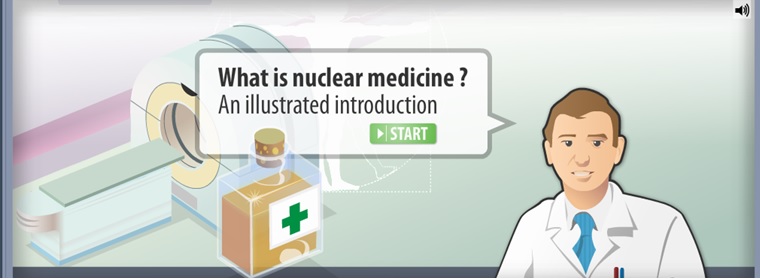Please click here to view an introductory video on Nuclear Medicine

The Association of Imaging Producers and Equipment Suppliers Nuclear Medicine Awareness Group and The Nuclear Medicine Community along with concerned physicians have produced a video to get closer to patients and explain the different stages
of a Nuclear Medicine exam in the simplest possible manner, as well as the origin of radio-pharmaceutical medication and its equipment interaction. Most of all the purpose of this video is to shed light on legitimate questions: the advantages and
possible risks of such exams
Please visit website here for more information
What is Nuclear Medicine
•Nuclear medicine is a safe and painless technique which provides medical images of the body.
•Nuclear medicine imaging procedures often identify abnormalities very early in the progress of disease, sometimes before problems
are apparent with other diagnostic tests.
• Nuclear medicine uses small amounts of radioactive materials as tracers to diagnose or treat disease. In diagnosing a condition, the radiation is detected by a special type of camera called a “Gamma
camera”. It provides visual
information about the area of the body being imaged by looking at the pattern of tracer-uptake.
• Radiation doses are kept as low as possible,particularly for scans on children.
What does a scan involve?
• During most nuclear medicine examinations, you will lie down on a scanning couch.
• The area being scanned is then placed underneath the camera heads. They will come close but they
will not touch you and you do not feel anything
from them.
• The camera heads either move around you in a circular motion or scan your body with one camera head placed
above and the other beneath you.
• You are not completely closed in during the scan.
• Staff
will be with you in the room at all times.
What are the common tests performed?
• To analyse kidney function and drainage.
• To image blood flow and function of the heart.
• To scan lungs for blood clots and other respiratory disorders.
• To evaluate bones
for fracture, infection, arthritis, etc.
• Brain scanning.
• To locate the presence of infection by white cell scanning.
• To measure thyroid function to detect an overactive thyroid gland.
• To measure kidney function for
accurate chemotherapy doses.
Nuclear Medicine Treatments
•Thyroid disorders
• Bone pain
• Knee joint pain and swelling
How do I get the results of the scan?
•The images taken are reported on by a radiologist (a specialist doctor trained in looking at this type of scan) and/or clinical scientists.
• The results will then be sent to the consultant who referred you.
• Your hospital
consultant will get in touch to give you the results of the scan at your next clinic appointment.
 An interview with Gerard McKiernan for BNMS2024 https://youtu.be/sP4eRjS1Hb4?si=ZF1RPE5ge2qbu5do
An interview with Gerard McKiernan for BNMS2024 https://youtu.be/sP4eRjS1Hb4?si=ZF1RPE5ge2qbu5do